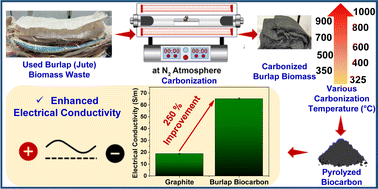Themed collection Biomass Materials

Introduction to biomass materials
Guest Editors Meisha Shofner and Andrew Tennyson introduce the Materials Advances Biomass Materials themed collection.

Mater. Adv., 2023,4, 2245-2246
https://doi.org/10.1039/D3MA90028B
Polylactic acid/wood-based in situ polymerized densified composite material
Development of an advanced wood bio-composite, using an economical and energy-efficient manufacturing strategy is showcased in this study.

Mater. Adv., 2023,4, 5633-5642
https://doi.org/10.1039/D3MA00550J
Hop natural fiber-reinforced poly(butylene succinate-co-butylene adipate) (PBSA) biodegradable plastics: effect of fiber length on the performance of biocomposites
Three sizes of hop fibers were tested at 30 wt% in PBSA biocomposites for material performance. Fibre length and size distribution were found to be key factors on mechanical and thermal properties of natural fiber-reinforced composites.

Mater. Adv., 2023,4, 1502-1514
https://doi.org/10.1039/D2MA00831A
Particle alignment effects on mechanical properties of cellulose nanocrystal thin films
The fracture mechanics of cellulose nanocrystal (CNC) thin films are strongly dependent on their alignment direction relative to the loading direction.

Mater. Adv., 2023,4, 1053-1061
https://doi.org/10.1039/D2MA00870J
Heterogeneous catalytic conversion of solid anaerobic digestate waste to biofuels and value-added chemicals
This paper investigates the catalytic hydrogenolysis of solid digestate from anaerobic digestion to extract biofuel.

Mater. Adv., 2023,4, 1041-1052
https://doi.org/10.1039/D2MA00811D
Insulative wood materials templated by wet foams
Insulative materials from forest residues prepared by oven-drying.

Mater. Adv., 2023,4, 641-650
https://doi.org/10.1039/D2MA00852A
Lignin-derivable alternatives to petroleum-derived non-isocyanate polyurethane thermosets with enhanced toughness
Lignin-derivable non-isocyanate polyurethane thermosets are highlighted as potential alternatives to petroleum-derived analogues with significant enhancement in toughness without compromising other application-specific thermomechanical properties.

Mater. Adv., 2023,4, 110-121
https://doi.org/10.1039/D2MA00895E
Upcycling of waste jute biomass to advanced biocarbon materials: the effect of pyrolysis temperature on their physicochemical and electrical properties
Burlap biocarbon pyrolyzed at 1000 °C showed a 250% improvement in electrical conductivity compared to commercial graphite.

Mater. Adv., 2022,3, 9071-9082
https://doi.org/10.1039/D2MA00678B
Optimization of spray-coated nanochitin/nanocellulose films as renewable oxygen barrier layers via thermal treatment
A simple method of enhancing the oxygen barrier property of a renewable polysaccharide-based multilayer film by increasing the processing temperatures.

Mater. Adv., 2022,3, 8351-8360
https://doi.org/10.1039/D2MA00832G
Grow with the flow – observing the formation of rheotactically patterned bacterial cellulose networks
Rheotactic structures: hierarchically and anisotropically structured textiles obtained by the growth of bacterial cellulose under flow, constituting porous substrates for potential applications as e.g. adsorbents or mineralization templates.

Mater. Adv., 2022,3, 6191-6207
https://doi.org/10.1039/D2MA00115B
Thermomorphological and mechanical properties of vulcanized octenyl succinate/terpenoid-derivatized corn starch composites
Successive modification of starch with octenyl succinic anhydride (OSA) and plant-derived geraniol allows for a largely bio-derived starch derivative that can undergo facile reaction with elemental sulfur to generate sustainable composite materials.

Mater. Adv., 2022,3, 4186-4193
https://doi.org/10.1039/D1MA01202A